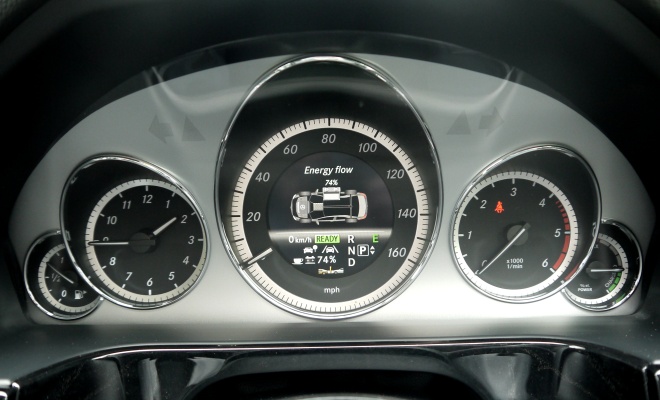
Rating: 5 out of 5 stars
Good: Highly refined, impressive economy, attractive interior
Bad: Costly next to an E250 diesel, not much else
Price: from £39,645
If you’re new to driving a Mercedes, it might take a moment to orientate yourself behind the wheel of the new E300 BlueTec Hybrid. By which I mean I don’t usually drive a Mercedes, and I can’t find the gearstick. Or the handbrake. Or the indicators. Good: Highly refined, impressive economy, attractive interior
Bad: Costly next to an E250 diesel, not much else
Price: from £39,645
Eventually, all three emerge from their hiding places. The lever for engaging the seven-speed automatic transmission turns out to be a stalk behind the wheel – where most cars put their windscreen wipers. The handbrake proves to be that thing that looks like an ashtray in front of my right knee. And what feels like an indicator stalk actually governs the cruise control – the indicators themselves are still lurking behind the wheel, just a bit lower down than expected.

Thus familiarised, it’s time to wake up the horses with a twist of the blunt plastic key-thing. And of course the result is silence, because this is a hybrid. The slumbering 2.1-litres of four-cylinder diesel soon joins in as I exit the car-park. The engine’s thrum has been smothered both in terms of noise and vibration, resulting in a sound not unlike somebody vacuuming the house next door.
The engine’s 204bhp is supplemented by a 27bhp (20kW) electric motor, which has been squeezed into the transmission housing between crankshaft and gearbox, alongside an automated clutch. Both the engine and motor thus drive the rear wheels, either joining forces or each acting alone as conditions (and battery reserves) allow. The 0.8kWh lithium-ion battery is relatively modest both in capacity and size, allowing it to be stashed under the bonnet rather than under the seats or boot floor.
The particular car I’m driving recently completed an 830-mile journey up Britain’s spine, achieving 67.3mpg along the way – better than the official combined cycle score of 65.7mpg (which comes paired with 109g/km on the most modest 16-inch wheel option).

Today I’m achieving – well, not quite as good a result. Let’s call it 50ish mpg, on account of my need to conduct an exhaustive and thorough investigation of the claimed 7.5-second sprint to 62mph. Like I said, I don’t get to drive a Mercedes every day.
By default the car runs in an economy mode, but there is a button on the centre console to activate a sportier setting. It provides a noticeable difference in throttle response, making an already lively car feel perkier still.
Before climbing aboard I’d read that the brakes might be a weak point, with a noticeable transition between regenerative and mechanical braking as the car slows or stopping force increases. I try and fail to replicate the issue – and I know what to look out for as some hybrids I’ve driven make a pig’s ear of this process. In the E300 I drove, with nicely bedded-in brakes, shedding speed felt natural and seamless.
With decent power and rear-wheel drive, there is fun to be found in this large, 1,875kg executive car – indeed it starts to feel surprisingly small and agile on the move. And that’s despite a prominent three-pointed star providing a constant reminder of exactly how long the bonnet is. But in truth this luxury hybrid feels happier when asked to waft than to wiggle. There are paddles to control the transmission, for example, but I can’t imagine ever using them in anger.

Similarly, the instrument panel is intent on providing oodles of information that most people will find very easy to ignore. A small circular digital screen set into the middle of the speedometer provides a broad selection of data, which you can scroll through using buttons on the steering wheel. There’s the obligatory hybrid animation showing energy flows from engine to back axle to battery and back again, plus trip data and economy scores, but the screen I’d summon up every day is simply the digital speedometer.
The bright and clear centre-console screen also provides much of the same data in any case. Though very good, the screen is not quite as crisp as the widescreen item fitted to the latest BMWs, and the graphics and rotary joystick controller also lag a short step behind.

Comfort and upmarket ambience feel on a par with the 5-Series, although I must admit that this particular E-Class has been kitted out quite comprehensively. The £2,885 lavished on the Luxury package has brought soft Nappa leather seats, a panoramic sunroof, attractively stitched faux-leather on the dashboard and Alcantara pillars. Another £1,225 spent on the Memory package has provided motorised front seating and steering wheel adjustment – including the ability to put the lumbar bolster in exactly the right spot. Anyone who can’t get comfy with that lot probably requires surgical intervention.
A reversing camera, adaptive bi-xenon lamps, audio upgrades and sundry driving aids round out the extras and bump up the total from the base £39,645 to a blink-inducing £52,110.
At that price, I’m not sure the E300 hybrid will make financial sense even for the company car users at which it is squarely aimed. The E250 CDI BlueEfficiency, offering the same engine without hybridisation, scores 57.7mpg on the combined cycle and lists for £6,310 less. Which would buy quite a lot of stitched faux leather and Nappa seats.

For those who can shrug off the extra outlay, the new Mercedes E300 is a quick, refined, effortless and well engineered executive hybrid. I wish it were lighter – it’s inescapably wasteful to cart around almost two tonnes on every trip – but it is less hefty than some rivals such as the Lexus GS450h.
All in all, it deserves a full deck of stars.



